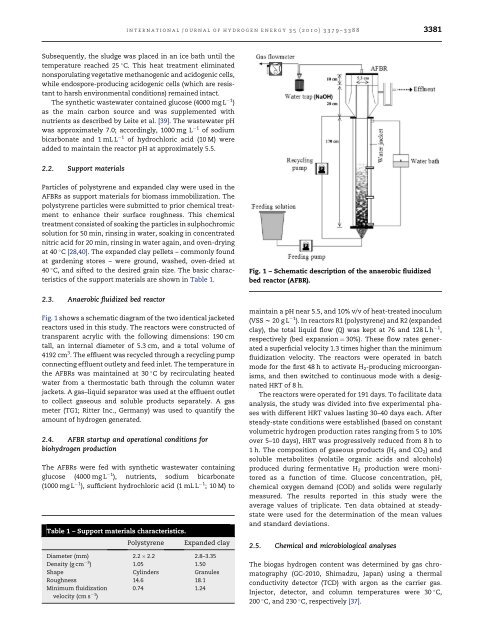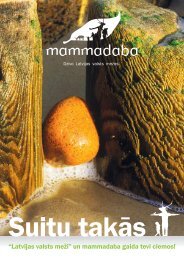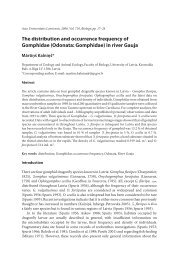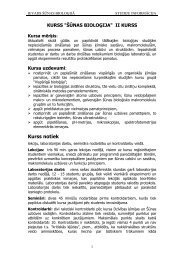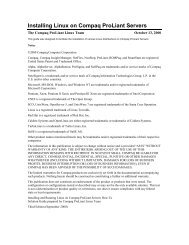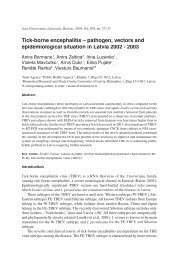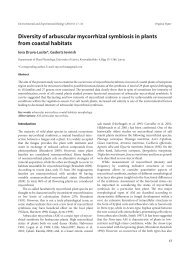Biohydrogen production in anaerobic fluidized bed reactors: Effect of ...
Biohydrogen production in anaerobic fluidized bed reactors: Effect of ...
Biohydrogen production in anaerobic fluidized bed reactors: Effect of ...
Create successful ePaper yourself
Turn your PDF publications into a flip-book with our unique Google optimized e-Paper software.
<strong>in</strong>ternational journal <strong>of</strong> hydrogen energy 35 (2010) 3379–3388 3381<br />
Subsequently, the sludge was placed <strong>in</strong> an ice bath until the<br />
temperature reached 25 C. This heat treatment elim<strong>in</strong>ated<br />
nonsporulat<strong>in</strong>g vegetative methanogenic and acidogenic cells,<br />
while endospore-produc<strong>in</strong>g acidogenic cells (which are resistant<br />
to harsh environmental conditions) rema<strong>in</strong>ed <strong>in</strong>tact.<br />
The synthetic wastewater conta<strong>in</strong>ed glucose (4000 mg L 1 )<br />
as the ma<strong>in</strong> carbon source and was supplemented with<br />
nutrients as descri<strong>bed</strong> by Leite et al. [39]. The wastewater pH<br />
was approximately 7.0; accord<strong>in</strong>gly, 1000 mg L 1 <strong>of</strong> sodium<br />
bicarbonate and 1 mL L 1 <strong>of</strong> hydrochloric acid (10 M) were<br />
added to ma<strong>in</strong>ta<strong>in</strong> the reactor pH at approximately 5.5.<br />
2.2. Support materials<br />
Particles <strong>of</strong> polystyrene and expanded clay were used <strong>in</strong> the<br />
AFBRs as support materials for biomass immobilization. The<br />
polystyrene particles were submitted to prior chemical treatment<br />
to enhance their surface roughness. This chemical<br />
treatment consisted <strong>of</strong> soak<strong>in</strong>g the particles <strong>in</strong> sulphochromic<br />
solution for 50 m<strong>in</strong>, r<strong>in</strong>s<strong>in</strong>g <strong>in</strong> water, soak<strong>in</strong>g <strong>in</strong> concentrated<br />
nitric acid for 20 m<strong>in</strong>, r<strong>in</strong>s<strong>in</strong>g <strong>in</strong> water aga<strong>in</strong>, and oven-dry<strong>in</strong>g<br />
at 40 C [28,40]. The expanded clay pellets – commonly found<br />
at garden<strong>in</strong>g stores – were ground, washed, oven-dried at<br />
40 C, and sifted to the desired gra<strong>in</strong> size. The basic characteristics<br />
<strong>of</strong> the support materials are shown <strong>in</strong> Table 1.<br />
Fig. 1 – Schematic description <strong>of</strong> the <strong>anaerobic</strong> <strong>fluidized</strong><br />
<strong>bed</strong> reactor (AFBR).<br />
2.3. Anaerobic <strong>fluidized</strong> <strong>bed</strong> reactor<br />
Fig. 1 shows a schematic diagram <strong>of</strong> the two identical jacketed<br />
<strong>reactors</strong> used <strong>in</strong> this study. The <strong>reactors</strong> were constructed <strong>of</strong><br />
transparent acrylic with the follow<strong>in</strong>g dimensions: 190 cm<br />
tall, an <strong>in</strong>ternal diameter <strong>of</strong> 5.3 cm, and a total volume <strong>of</strong><br />
4192 cm 3 . The effluent was recycled through a recycl<strong>in</strong>g pump<br />
connect<strong>in</strong>g effluent outlety and feed <strong>in</strong>let. The temperature <strong>in</strong><br />
the AFBRs was ma<strong>in</strong>ta<strong>in</strong>ed at 30 C by recirculat<strong>in</strong>g heated<br />
water from a thermostatic bath through the column water<br />
jackets. A gas–liquid separator was used at the effluent outlet<br />
to collect gaseous and soluble products separately. A gas<br />
meter (TG1; Ritter Inc., Germany) was used to quantify the<br />
amount <strong>of</strong> hydrogen generated.<br />
2.4. AFBR startup and operational conditions for<br />
biohydrogen <strong>production</strong><br />
The AFBRs were fed with synthetic wastewater conta<strong>in</strong><strong>in</strong>g<br />
glucose (4000 mg L 1 ), nutrients, sodium bicarbonate<br />
(1000 mg L 1 ), sufficient hydrochloric acid (1 mL L 1 ;10M)to<br />
Table 1 – Support materials characteristics.<br />
Polystyrene Expanded clay<br />
Diameter (mm) 2.2 2.2 2.8–3.35<br />
Density (g cm 3 ) 1.05 1.50<br />
Shape Cyl<strong>in</strong>ders Granules<br />
Roughness 14.6 18.1<br />
M<strong>in</strong>imum fluidization<br />
velocity (cm s 1 )<br />
0.74 1.24<br />
ma<strong>in</strong>ta<strong>in</strong> a pH near 5.5, and 10% v/v <strong>of</strong> heat-treated <strong>in</strong>oculum<br />
(VSS w 20 g L 1 ). In <strong>reactors</strong> R1 (polystyrene) and R2 (expanded<br />
clay), the total liquid flow (Q) was kept at 76 and 128 L h 1 ,<br />
respectively (<strong>bed</strong> expansion ¼ 30%). These flow rates generated<br />
a superficial velocity 1.3 times higher than the m<strong>in</strong>imum<br />
fluidization velocity. The <strong>reactors</strong> were operated <strong>in</strong> batch<br />
mode for the first 48 h to activate H 2 -produc<strong>in</strong>g microorganisms,<br />
and then switched to cont<strong>in</strong>uous mode with a designated<br />
HRT <strong>of</strong> 8 h.<br />
The <strong>reactors</strong> were operated for 191 days. To facilitate data<br />
analysis, the study was divided <strong>in</strong>to five experimental phases<br />
with different HRT values last<strong>in</strong>g 30–40 days each. After<br />
steady-state conditions were established (based on constant<br />
volumetric hydrogen <strong>production</strong> rates rang<strong>in</strong>g from 5 to 10%<br />
over 5–10 days), HRT was progressively reduced from 8 h to<br />
1 h. The composition <strong>of</strong> gaseous products (H 2 and CO 2 )and<br />
soluble metabolites (volatile organic acids and alcohols)<br />
produced dur<strong>in</strong>g fermentative H 2 <strong>production</strong> were monitored<br />
as a function <strong>of</strong> time. Glucose concentration, pH,<br />
chemical oxygen demand (COD) and solids were regularly<br />
measured. The results reported <strong>in</strong> this study were the<br />
average values <strong>of</strong> triplicate. Ten data obta<strong>in</strong>ed at steadystate<br />
were used for the determ<strong>in</strong>ation <strong>of</strong> the mean values<br />
and standard deviations.<br />
2.5. Chemical and microbiological analyses<br />
The biogas hydrogen content was determ<strong>in</strong>ed by gas chromatography<br />
(GC-2010, Shimadzu, Japan) us<strong>in</strong>g a thermal<br />
conductivity detector (TCD) with argon as the carrier gas.<br />
Injector, detector, and column temperatures were 30 C,<br />
200 C, and 230 C, respectively [37].


